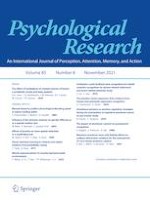04-01-2021 | Original Article
Non-symbolic numerosity encoding escapes spatial frequency equalization
Gepubliceerd in: Psychological Research | Uitgave 8/2021
Log in om toegang te krijgenAbstract
The exact visual mechanisms underpinning the approximate number system are still debated. Recent evidence suggests that numerosity is extracted on segmented visual objects, at least for a moderate numerical range (e.g., < 100 items), whereas alternative models rather propose that numerosity is derived from low-level features (e.g., power spectrum) of an unsegmented image, independently from the range. Here, to disentangle these accounts, we generated stimuli that were equalized for spatial frequency amplitude spectrum and luminance across sets of moderate range numerosities (e.g., 9–15 dots), while independently manipulating the perceived item segmentation by connecting dots with illusory contours (ICs). In Experiment 1, participants performed a numerical discrimination task, in which they had to select the numerically larger between two stimuli: a reference stimulus (always 12 dots) and a test stimulus (from 9 to 15 dots) containing 0, 2 or 4 pairs of dots grouped by ICs lines. In Experiment 2, participants were presented only the test stimulus and performed an estimation task. Results clearly showed that in both experiments participants’ performance followed well-known numerical signatures (e.g., distance effect and scalar variability), with numerosity that was underestimated as the illusory connections increased. Crucially, this was found despite spatial frequencies and luminance were kept constant across all the experimental stimuli and these variables were thus uninformative about numerosity. Taken together, these findings indicate that power spectrum in its own cannot explain numerical processing. Rather, visual segmentation mechanisms may be crucial in such processing at least for a moderate numerosity range.
